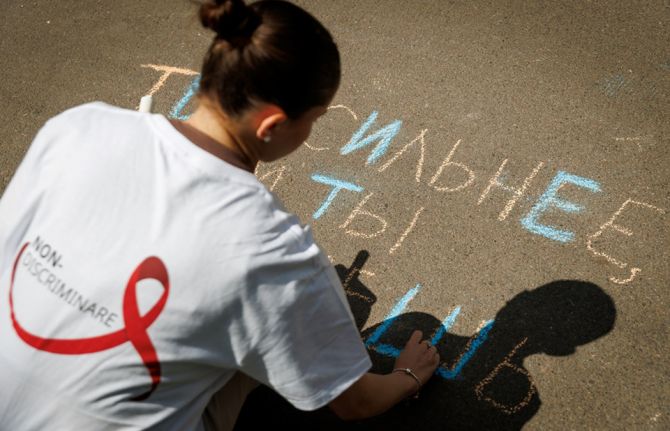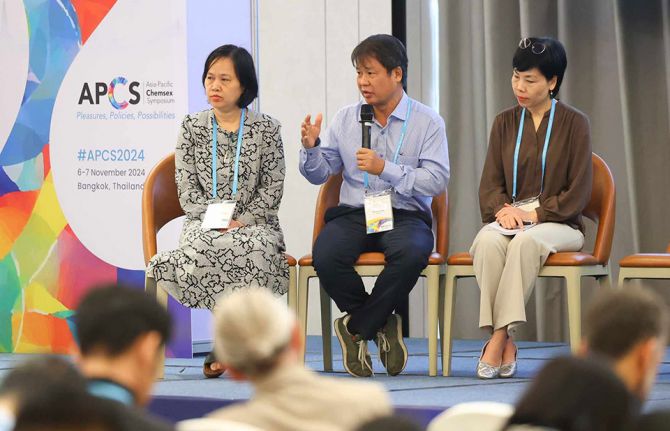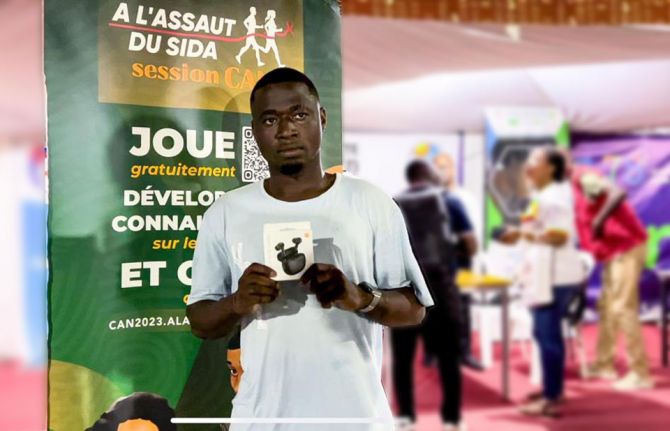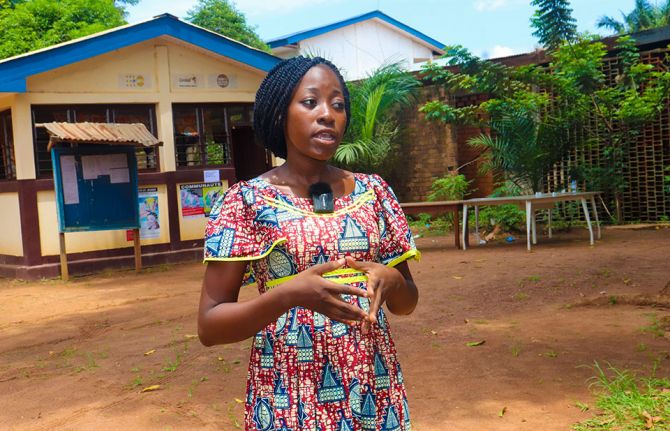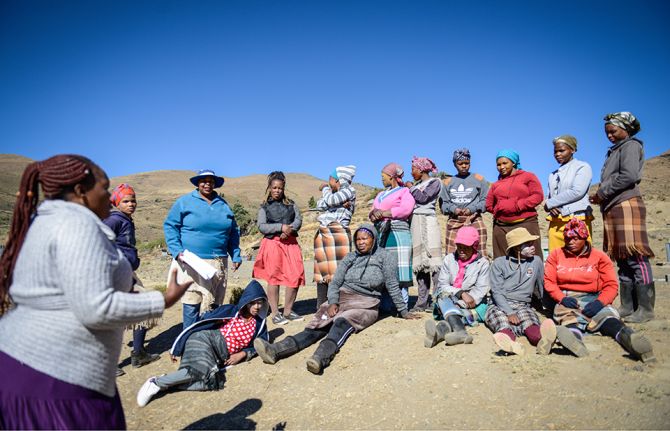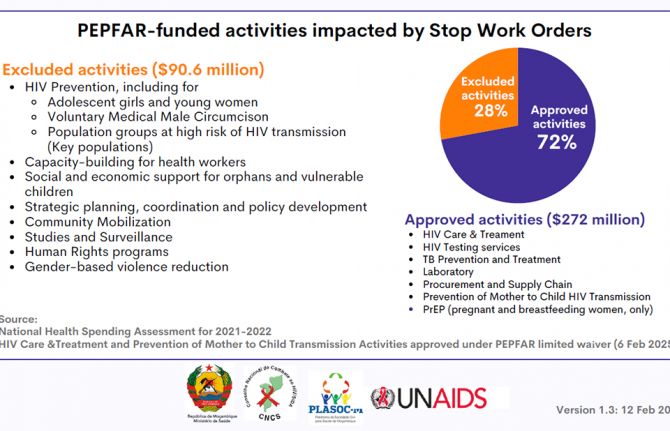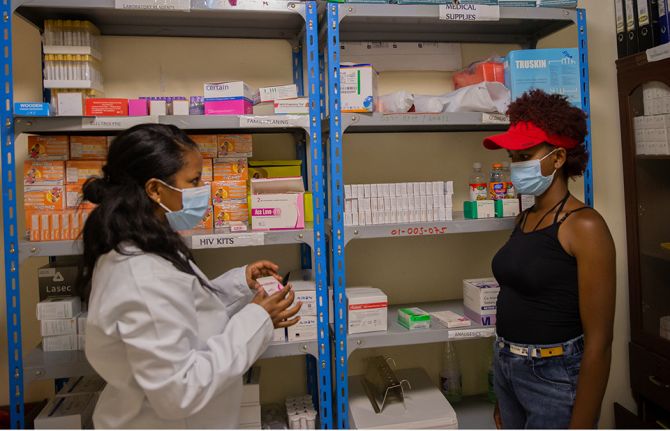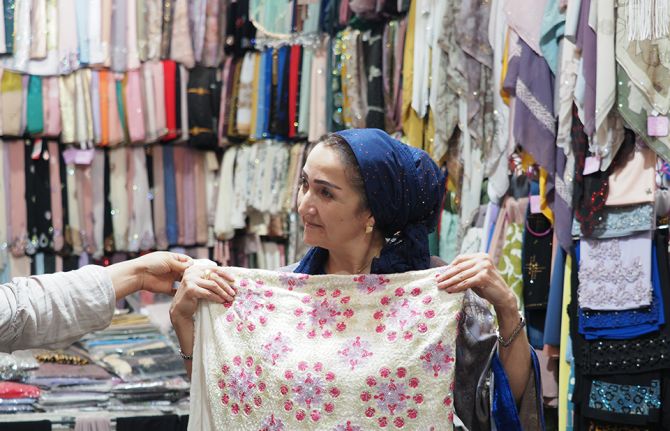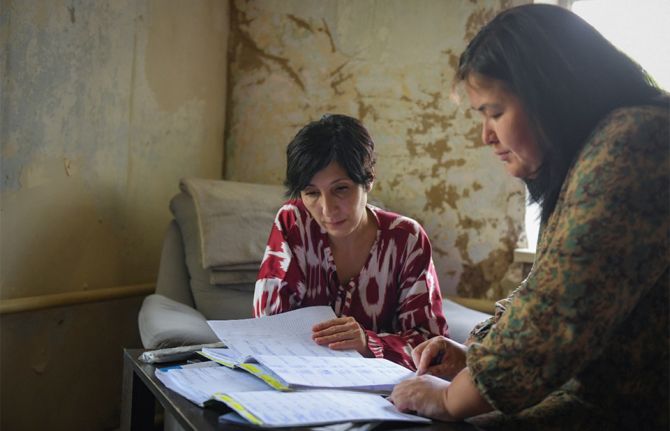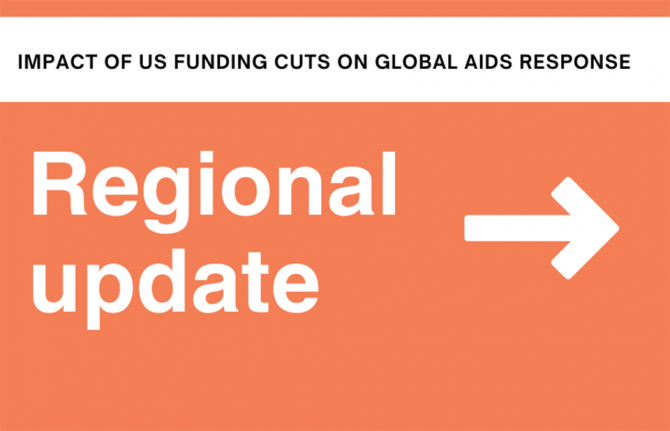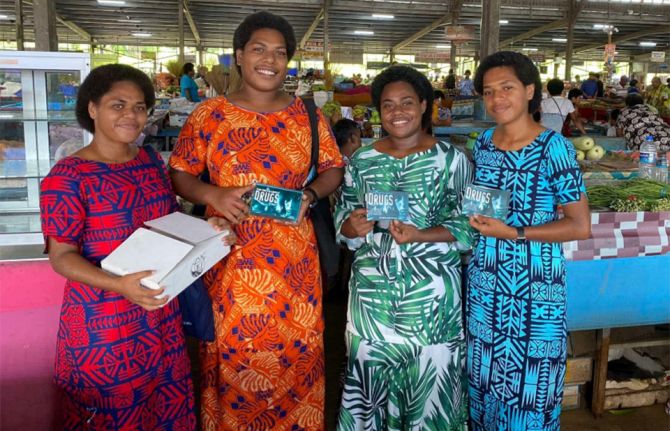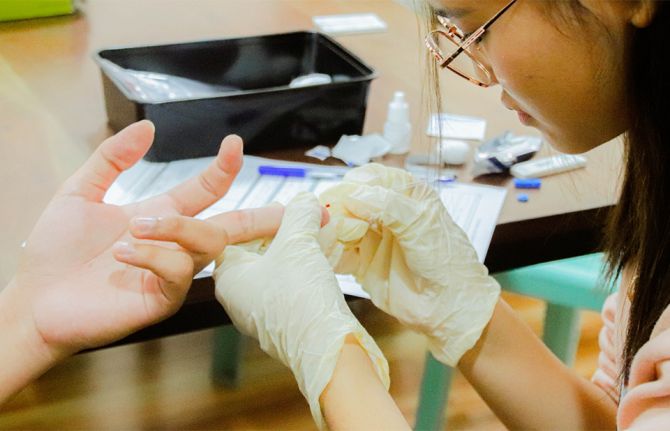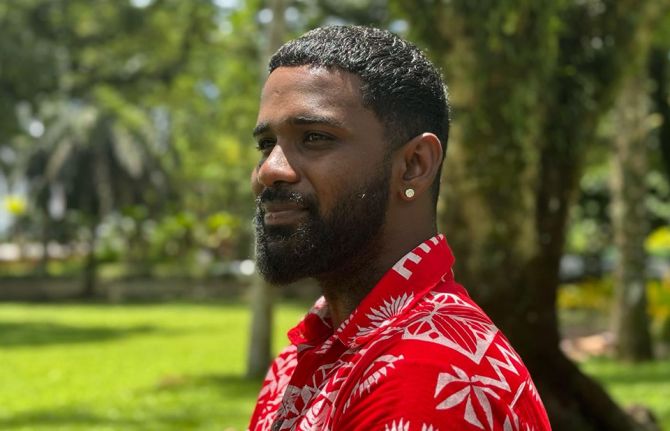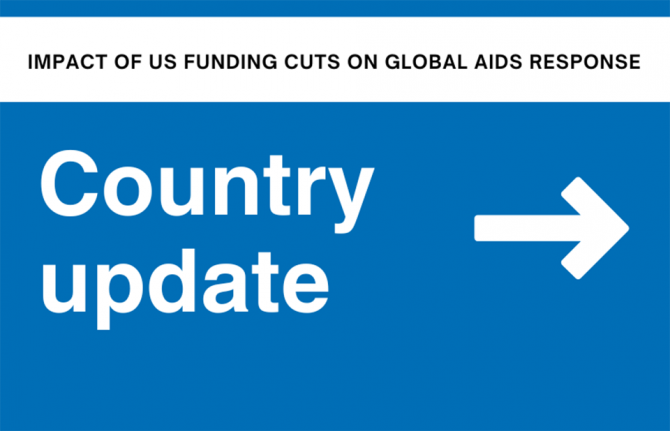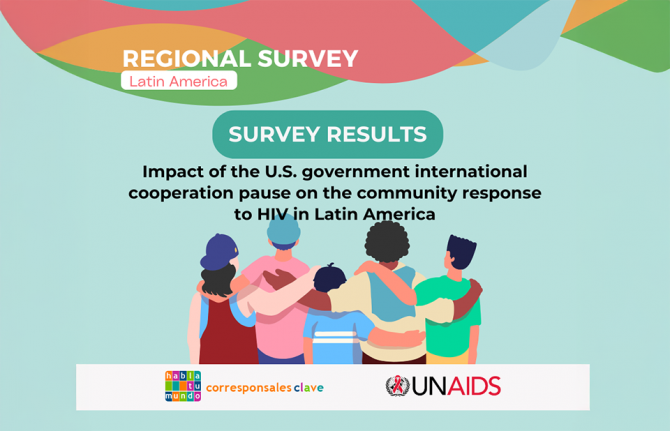
Feature Story
Anti-homophobia campaign to end discrimination in Latin America
16 May 2009
16 May 2009 16 May 2009May 17 marks the International Day Against Homophobia which is an initiative to end discrimination and demand respect for the rights of homosexuals, transsexuals and lesbians.
Many countries in Latin America have planned activities to celebrate the Day such as marches, festivals, awareness raising workshops and campaigns to promote respect for sexual diversity.
UNAIDS Regional Director Dr Cesar Antonio Nuñez highlighted the need for all Latin American countries to observe the International Day Against Homophobia and Transphobia as an opportunity to strengthen the work being done around human rights to create a more effective response to AIDS in the region.
One of the new initiatives of this year’s celebration is an on-line campaign displaying messages against homophobia and transphobia. The campaign, which runs under the theme “For sexual rights and sexual diversity” was produced by the regional offices of UNAIDS and UNDP in collaboration with the Latin American Network of Transsexual People (REDLACTRANS), the Association for integral health and citizenship in Latin America (ASICAL) and the Latin American and Caribbean Council of AIDS Services Organizations for LAC (LACCASO).
“Let’s put an end to violence, let’s overcome the indifference” or “Homophobia accelerates the spread of HIV” are some of the campaign messages being displayed on web sites and played on YouTube. UNAIDS Brazil has adapted these spots into Portuguese.
Sex between men is the main mode of HIV transmission in Latin America and homophobia and stigma remain significant stumbling blocks to an effective response to the epidemic. Stigma and homophobia increase the isolation of gays, bisexuals and transgender people making them more reluctant to come forward, be identified and get advice and HIV services.
Many Latin American countries have laws that defend sexual freedom and orientation. For example with law reform in Nicaragua and Panama over the past 12 months, there are now no states in Latin America which criminalize homosexual relations.
Yet Latin America is widely regarded as having a long way to go to successfully counter homophobia, or “fear or hatred of homosexuals.” According to the UN, homosexual and trans people are frequently insulted, fired from jobs, and barred from community activities. .
Right Hand Content
Feature stories:
International Day against Homophobia (14 May 2009)
HIV prevention hampered by homophobia (13 January 2009)
International Day against Homophobia (16 May 2008)
Press centre:
AIDS responses failing men who have sex with men and transgender populations (15 May 2009)
Statement by Mr Michel Sidibé, Executive Director of UNAIDS, on occasion of the International Day Against Homophobia, 17 May (15 May 2009)
External links:

Feature Story
New same sex and transgender Action Framework
15 May 2009
15 May 2009 15 May 2009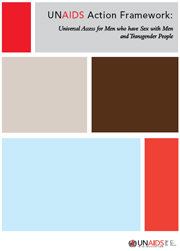
Universal access to appropriate HIV programmes for men who have sex with men and transgender people is a crucial part of achieving universal access as a whole.
Ahead of the International Day Against Homophobia (17 May), the Joint United Nations Programme on HIV/AIDS (UNAIDS) and the United Nations Development Programme (UNDP) launched a new UNAIDS Action Framework on Universal Access for Men who have Sex with Men and for Transgender People. The Framework sets out how UNAIDS will facilitate and support universal access to HIV prevention, treatment, care and support for men who have sex with men and transgender people.
Acknowledging that ‘business as usual’ is no longer a viable response to the HIV-related risks of these groups, the Framework shows that collective responses to HIV in the men who have sex with men and transgender populations are failing. The problem has either been ignored – with insufficient data and analysis – or commitment and resources allocated to HIV programming in these populations fall far short of what is required.
“The failure to respond effectively has allowed HIV rates to reach crisis levels in many communities of men who have sex with men and transgender people,” said Michel Sidibé, Executive Director of UNAIDS. “Efforts to reverse this crisis must be grounded in human rights and underpinned by the decriminalisation of homosexuality,” he added.
The failure to respond effectively has allowed HIV rates to reach crisis levels in many communities of men who have sex with men and transgender people.
Michel Sidibé, Executive Director of UNAIDS
The approach taken in the Framework aims to reduce the incidence of HIV everywhere, while protecting the health and rights of not only men who have sex with men and transgender people, but also their female sexual partners and the rest of the population. Responding to HIV among marginalized groups is therefore not just important in and of itself, it is often one of the most effective strategies to reduce heterosexual spousal transmission and to avert larger heterosexual epidemics. Universal access to appropriate HIV programmes for men who have sex with men and transgender people is a crucial part of achieving universal access as a whole.
“If we are going to make universal access for sexual minorities a meaningful reality, we must work towards ending homophobia and transphobia. We must address the legal and policy barriers,” said Jeffery O’Malley, Director of UNDP’s HIV group.
The Framework sets out how the UNAIDS Secretariat and its Cosponsors will work towards universal access for these often marginalized groups through three objectives:
(1) To improve the human rights situation for men who have sex with men and transgender people. In his statement to the International AIDS Conference in August 2008, the UN Secretary-General outlined the dangers of not protecting the legal and human rights of sex workers, drug users, and men who have sex with men, pointing out that in countries where such rights are enshrined in law, the result is fewer infections, less demand for antiretroviral treatment and fewer deaths.
(2) To strengthen and promote the evidence base on men who have sex with men, transgender people and HIV. Better quality data, from as wide a range of sources as necessary, is needed to inform, develop and advocate new policies and programmatic responses. UNAIDS and its Cosponsors will build upon their current work with partners to strengthen the knowledge base.
(3) To strengthen capacity and promote partnerships to ensure broader and better responses for men who have sex with men, transgender people and HIV. Ensuring sufficient capacity in intergovernmental, governmental and nongovernmental organizations to appropriately address diverse sexuality and HIV is vital if men who have sex with men and transgender people are to get universal access to HIV-related services. The Framework sets out how the scale-up of capacity can be achieved.
The joint UNAIDS programme, utilizing the strengths of all its Cosponsors, is committing itself to interagency UNAIDS action to improve global and national HIV-related efforts for men who have sex with men and transgender people.
An interagency working group will develop a system to monitor and evaluate the approach and work proposed in the Framework, develop the strategic approach of UNAIDS and its Cosponsors’, develop, monitor and evaluate detailed workplans, periodically review and evaluate their strategic approach and report on the activities undertaken.
Right Hand Content
Feature stories:
International Day against Homophobia (15 May 2009)
Hidden HIV epidemic amongst MSM in Eastern Europe and Central Asia (26 January 2009)
China to tackle HIV indidence amongst MSM (16 January 2009)
HIV prevention hampered by homophobia (13 January 2009)
ICASA 2008: Men who have sex with men and HIV in Africa (07 December 2008)
Press centre:
AIDS responses failing men who have sex with men and transgender populations (15 May 2009)
Statement by Mr Michel Sidibé, Executive Director of UNAIDS, on occasion of the International Day Against Homophobia, 17 May (15 May 2009)
UNAIDS expresses concern over decision by Burundian National Assembly to criminalize same sex relations (27 April 2009)
UNAIDS welcomes the release of nine men in Senegal imprisoned for their sexual orientation (20 April 2009)
UNAIDS and broad coalition working towards the release of nine men who have sex with men in Senegal who have been convicted and imprisoned (15 January 2009)
Criminalization of sexual behavior and transmission of HIV hampering AIDS responses (27 November 2008)
Multimedia:
![]()
![]() UNAIDS delivers a strong message at the 23 TEDDY Award in Berlin
UNAIDS delivers a strong message at the 23 TEDDY Award in Berlin
Publications:
UNAIDS Action Framework on Universal Access for Men who have Sex with Men and Transgender People (pdf, 274 Kb.)
Related

Feature Story
International Day against Homophobia
14 May 2009
14 May 2009 14 May 2009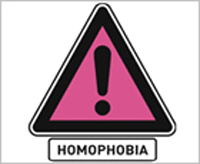
Homophobia and criminalization of consensual adult sexual behaviour represent major barriers to effective responses to HIV.
By signing the 2006 United Nations Political Declaration on HIV/AIDS, governments committed to removing legal barriers and passing laws to protect vulnerable populations. However, over 80 countries still criminalize consensual same sex acts among adults.
It is against this repressive context that communities worldwide celebrate the International Day Against Homophobia each 17 May, which marks the anniversary of the World Health Organization’s decision to remove homosexuality from its list of mental disorders in 1990. Therefore, 17 May is an opportunity to highlight once again the urgent need for joint efforts to reduce and end discrimination, violence and criminalization based on sexual orientation.
Homophobia and criminalization of consensual adult sexual behaviour represent major barriers to effective responses to HIV. Such responses depend on the protection of the dignity and rights of all people affected by HIV, including their right and ability to organize and educate their communities, advocate on their behalf, and access HIV prevention and treatment services.
“The decision to criminalize same sex relations is a serious setback to the AIDS response and to the rights of those affected by the law,” said Michel Sidibé, Executive Director of UNAIDS. “As these discriminatory laws can drive people underground, they will have a negative impact both on the delivery of HIV prevention programmes and on access to treatment for those living with HIV.”
Evidence shows that protection of the rights of men who have sex with men, lesbians and transgenders, both in law and practice, combined with scaled-up HIV programming to address their HIV and health needs are necessary and complementary components for a successful response to the epidemic.
UNAIDS urges all governments to take steps to eliminate stigma and discrimination faced by men who have sex with men, lesbians and transgenders and create social and legal environments that ensure respect for human rights and universal access to HIV prevention, treatment, care and support.
“There is no place for homophobia. Universal access to HIV prevention, treatment, care and support must be accessible to all people in need—including men who have sex with men,” said UNAIDS Executive Director Michel Sidibé.
Countries that have non-discrimination laws against men who have sex with men, injecting drug users and sex workers have achieved higher rates of coverage of HIV prevention efforts.
Right Hand Content
Feature stories:
Anti-homophobia campaign to end discrimination in Latin America (16 May 2009)
Hidden HIV epidemic amongst MSM in Eastern Europe and Central Asia (26 January 2009)
China to tackle HIV indidence amongst MSM (16 January 2009)
HIV prevention hampered by homophobia (13 January 2009)
ICASA 2008: Men who have sex with men and HIV in Africa (07 December 2008)
MSM and the global HIV epidemic (31 July 2008)
Strengthening work with MSM in Africa (23 May 2008)
International Day against Homophobia (16 May 2008)
International Day against Homophobia 2007 (17 May 2007)
Press centre:
AIDS responses failing men who have sex with men and transgender populations (15 May 2009)
Statement by Mr Michel Sidibé, Executive Director of UNAIDS, on occasion of the International Day Against Homophobia, 17 May (15 May 2009)
UNAIDS expresses concern over decision by Burundian National Assembly to criminalize same sex relations (27 April 2009)
UNAIDS welcomes the release of nine men in Senegal imprisoned for their sexual orientation (20 April 2009)
UNAIDS and broad coalition working towards the release of nine men who have sex with men in Senegal who have been convicted and imprisoned (15 January 2009)
Criminalization of sexual behavior and transmission of HIV hampering AIDS responses (27 November 2008)
Multimedia:
![]()
![]() UNAIDS delivers a strong message at the 23 TEDDY Award in Berlin
UNAIDS delivers a strong message at the 23 TEDDY Award in Berlin

Feature Story
Global online forum to give teachers a voice on HIV
14 May 2009
14 May 2009 14 May 2009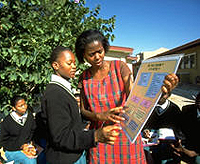
The global online forum will give teachers and their partners the chance to exchange ideas and expertise on how to challenge HIV more effectively
Credit: UNAIDS G. Pirozzi
Teachers have a critical role to play in mounting a successful response to HIV in schools and yet evidence of effective teacher involvement in the challenge to the epidemic is scarce and scattered and lessons learned have not been universally discussed and shared.
In order to review progress made and identify ways forward, UNESCO's International Institute for Educational Planning (IIEP) and the UNAIDS Inter-Agency Task Team on Education are organizing an E-Forum on ‘Teachers and HIV & AIDS: Reviewing achievements, identifying challenges’ from 18 to 29 May 2009.
The forum will bring together a wide range of actors including educational planners, policy-makers, representatives of teachers' unions and teaching staff, networks of teachers living with HIV, civil society groups, donors, UNAIDS cosponsors and other multilateral agencies. They will exchange views and experiences and explore how teachers can capitalize on their influence and expertise to mitigate the effects of an epidemic which is having a profound and negative impact on schools and entire education systems.
In many countries, curricula now include AIDS-related content and teachers themselves are often taking the lead. For example, the South African Democratic Teachers’ Union is building institutional capacity, providing training to support colleagues in examining their own vulnerability to infection, their awareness about HIV and their attitudes towards helping others avoid infection. Educators in general are given an important responsibility to ensure that children and young people acquire essential knowledge, skills and attitudes for prevention and that, in higher prevalence settings, pupils infected with and affected by HIV have access to care and support.

Credit: UNESCO
Without teachers, the endeavour to provide Education for All, which aims to meet the learning needs of every child, youth and adult by 2015, cannot be achieved. However, these professionals face profound challenges, including often difficult working environments (overcrowded classrooms, lack of materials) and poor or non-existent training. In many contexts, particularly in sub-Saharan Africa, teachers are profoundly affected by HIV. According to UNAIDS and WHO, in Zambia, for example, it is estimated that teacher illness (often AIDS-related) and the responsibilities of caring for family members, including attending funerals, account for over 60% of teacher absences. Additionally, stigma and discrimination, gender inequality, concerns around morality, cultural issues and relationships between teachers and students can make the environment in which school-based AIDS education occurs highly complex.
According to a joint statement by Mark Richmond, UNESCO’s Global Coordinator on HIV and AIDS and Mark Bray, Director of UNESCO’s IIEP, “The AIDS epidemic is raising many issues for the teaching profession, particularly in high prevalence settings.”
This forum promises to be a valuable opportunity… to enable the voices of teachers to be heard by all those responding to the challenges posed by HIV.
Mark Richmond, UNESCO’s Global Coordinator on HIV and AIDS and Mark Bray, Director of UNESCO’s IIEP
“This forum promises to be a valuable opportunity for teachers and other stakeholders to share their knowledge and experience and, even more importantly, to enable the voices of teachers to be heard by all those responding to the challenges posed by HIV,” they continued.
The outcomes of the Forum will feed directly into the Spring Meeting of the UNAIDS IATT on Education, hosted by Irish Aid, the Irish government’s assistance programme for developing nations. Taking place in June this year, the meeting has 'Teachers and HIV & AIDS: Reviewing achievements, identifying challenges' as its Symposium theme.
A report on the discussion will also be more widely available at the IIEP's HIV and AIDS Education Clearinghouse.
The Forum will invite the exchange of views on four interrelated sub-topics:
1. Involving teachers in HIV prevention - policy and management implications
2. Coverage and content of pre- and in- service training for teachers
3. The role of teachers in child protection and promotion of safe and healthy school environments
4. Supportive and enabling environments for teachers affected by HIV
All four sub-topics will be accessible over the course of the Forum which will be animated by e-moderators (IIEP and UNAIDS IATT Secretariat staff), with daily syntheses of discussions and commentary to guide further debate on these issues.
To join the Forum, please send an e-mail message to: hiv-aids-clearinghouse@iiep.unesco.org, stating your name, title, organization and nationality. You will then be sent detailed instructions on how to access the Forum and contribute to the discussion.
Please note that you can sign up at any time prior to or during the Forum but that it will be active only from 18 May.
For more information on the IATT Symposium in Ireland, please contact: info-iatt@unesco.org
Right Hand Content
Cosponsors:
Feature stories:
HIV response and the education sector: UNESCO Best practice series (04 May 2009)
Supporting young learners living with HIV in Namibia and Tanzania (23 December 2008)
ICASA 2008: Courage and hope, African teachers living positively (03 December 2008)
Publications:
Booklet 1: Overview (pdf, 2.62 Mb.)
Booklet 2: HIV & AIDS and Safe, Secure and Supportive Learning Environments (pdf, 5.06 Mb.)
Booklet 3: HIV & AIDS and Educator Development, Conduct and Support (pdf, 1.06 Mb.)
Booklet 4: Partnerships in Practice (pdf, 5.11 Mb.)
Booklet 5: Effective Learning (pdf, 3.70 Mb.)
Toolkit for Mainstreaming HIV and AIDS in the Education Sector: Guidelines for Development Cooperation Agencies. (UNAIDS IATT on Education, 2008) ( En | Fr | Es ) (pdf, 1,01 Mb | 904 Kb. | 1.02 Mb.)
Advocacy Briefing Notes – Girls’ Education and HIV Prevention. (UNAIDS IATT on Education, 2008) (pdf 252 Kb.)
Advocacy Briefing Notes – HIV and AIDS Education in Emergencies. (UNAIDS IATT on Education, 2008) (pdf, 275 Kb.)
Advocacy Briefing Notes – Mainstreaming HIV in Education. (UNAIDS IATT on Education, 2008) (pdf, 275 Kb.)
Advocacy Briefing Notes – Teachers Living with HIV and AIDS. (UNAIDS IATT on Education, 2008) (pdf, 273.9 Kb.)
Related

Feature Story
Finland increases its contribution to UNAIDS
14 May 2009
14 May 2009 14 May 2009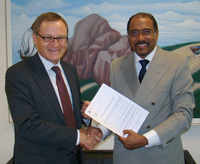
The Ambassador of Finland Mr Hannu Himanen (left) met with UNAIDS Executive Director Michel Sidibé in Geneva, 14 May 2009. Credit: UNAIDS
As a sign of its long-term commitment to the AIDS response and partnership, the Government of Finland has committed to increase its contribution to UNAIDS by 25% in 2009. The news of this increase in contribution was personally delivered to UNAIDS Executive Director Michel Sidibé by the Ambassador of Finland Mr Hannu Himanen in a meeting held in Geneva.
The success story of Finland’s approach of integrating AIDS in community systems is a social revolution.
Michel Sidibé, UNAIDS Executive Director
Coming just days after the 2009 UNAIDS Nordic Consultations, this contribution underscores Finland’s commitment to sustain and enhance UNAIDS work during the current financial and economic crisis.
According to Ambassador Himanen, “It is important to link primary health care systems with AIDS. Finland would like to work with UNAIDS to make this possible.”
“The success story of Finland’s approach of integrating AIDS in community systems is a social revolution,” said Michel Sidibé. “UNAIDS is proud to count Finland as a true partner in the global AIDS response.”
Right Hand Content
Feature stories:
UNAIDS in Oslo for Nordic Consultations (08 May 2009)

Feature Story
Romania discusses successful national AIDS response with UNAIDS
13 May 2009
13 May 2009 13 May 2009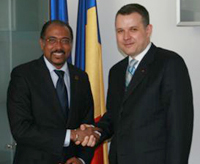
UNAIDS Executive Director Michel Sidibé (left) met with Mr Ion Bazac, Minister of Health of Romania, in Bucharest on 12 May 2009.
Credit: UNAIDS/E. Petrescu
During an official visit to Bucharest, UNAIDS Executive Director Michel Sidibé yesterday met with Mr Ion Bazac, Minister of Health of Romania.
The Executive Director praised Romania’s significant achievement of universal access to HIV treatment for all people living with HIV in need of it.
The meeting was an opportunity to discuss the importance of sustaining Romania’s success in the AIDS response during the current financial and economic crisis.
Mr Sidibé described AIDS as an opportunity to make progress on larger health and development goals through the integration of HIV services with wider health services including treatment of tuberculosis as well as sexual and reproductive health.
Minister Bazac reiterated Romania’s commitment to sustain HIV prevention activities that are currently being supported by the Global Fund to Fight AIDS, TB and Malaria. Minister Bazac also invited UNAIDS to collaborate with the Romania’s new training academy for HIV/AIDS and infectious diseases, which will be launched next month in Bucharest.
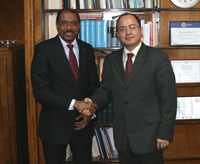
UNAIDS Executive Director Michel Sidibé (left) met with Bogdan Aurescu, Secretary of State of the Romanian Ministry of Foreign Affairs.
Credit: UNAIDS/E. Petrescu
In a later meeting with Bogdan Aurescu, Secretary of State of the Romanian Ministry of Foreign Affairs, Michel Sidibé discussed the potential for Romania to take a leadership role on political advocacy for AIDS and human rights, particularly in the European Union. Aurescu, a well-known legal expert and diplomat, expressed Romania's readiness to engage the European Union and the Council of Europe in these areas. The Secretary of State also expressed Romania's high regard for collaboration with UN and his commitment to sustain policy development, advocacy and technical cooperation on HIV through UNAIDS.
Right Hand Content
Multimedia:

Feature Story
UN Secretary General applauds efforts to address AIDS in Lao PDR
13 May 2009
13 May 2009 13 May 2009A version of this story first appeared on unicef.org
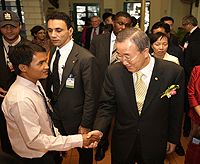
During a recent visit to a youth centre in the capital, Vientiane, Mr Ban met representatives of people living with HIV (PLHIV) including Mr Kinoy, from the Lao Network of People Living with HIV (LNP+).
Photo credit: UNICEF
Lao PDR/2009/Holmes.
The United Nations Secretary-General, Mr Ban Ki-moon, praised the efforts of the UN Country Team and its partners to support prevention, treatment, care and support activities for people living with HIV, and to raise knowledge and understanding of the issue in Lao PDR.
During a recent visit to a youth centre in the capital, Vientiane, Mr Ban met representatives of people living with HIV (PLHIV) including Mr Kinoy, from the Lao Network of People Living with HIV (LNP+).
Mr Kinoy thanked the Secretary-General for all the UN’s support to PLHIV in the Lao PDR. He said it was vital to ensure continued free access to treatment, care and support services for all in need, to address stigma and discrimination at all levels, and to strengthen the participation of PLHIV in the national response to AIDS.
The Joint UN Team on AIDS in Lao PDR is supporting PLHIV and a greater involvement of people living with HIV in many parts of the country, through capacity building, direct support for activities, and resource mobilization efforts. UNAIDS advocates for meaningful involvement of people living with HIV as one of the key elements of a continuously successful response to AIDS in the country.
UNAIDS, together with a support consortium consisting of several partners, works closely with LNP+ in developing the network as “the voice” of PLHIV. Support is also provided to local level PLHIV support groups to strengthen their self management and representation.
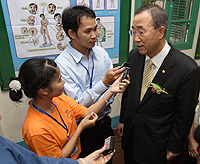
Mr Ban told the young reporters about his recent meeting with UN+ (the UN system HIV positive staff group) and his personal commitment to address stigma and discrimination.
Photo credit: UNICEF
Lao PDR/2009/Holmes.
“I am very much impressed by all that you are doing to help young people of Laos, to teach them awareness and the importance of prevention of HIV/AIDS,” the Secretary General told reporters from a UNICEF-supported youth radio programme.
He told the young reporters about his recent meeting with UN+ (the UN system HIV positive staff group) and his personal commitment to address stigma and discrimination.
Although rates of HIV infection are low in Laos compared to other parts of South East Asia, there are signs that it is gaining hold among some adolescent groups.
During his visit to the Vientiane Youth Centre, Mr Ban applauded the work being done by young counselors and volunteers – including a group of Buddhist monks – for helping people living with HIV to overcome stigma and integrate into society.
Pointing out that the global response to AIDS was a priority for the UN, Mr Ban added: “This is very important for the community, the government, and citizens of Laos to work together, to provide good counseling, provide good care and support and good source of encouragement to people living with HIV”.
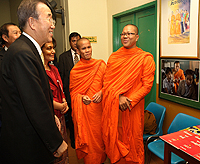
During his visit to the Vientiane Youth Centre, Mr Ban applauded the work being done by young counselors and volunteers – including a group of Buddhist monks – for helping people living with HIV to overcome stigma and integrate into society.
Photo credit: UNICEF
Lao PDR/2009/Holmes.
Established in 2001 under the Lao Women’s Union, the Vientiane Youth Centre is a pioneering initiative designed to promote youth capacity development and empowerment. With assistance from the UN Population Fund, the UN Office on Drugs and Crime and UNICEF, the Centre supports a telephone hotline offering advice on AIDS issues, a clinic providing reproductive health services and peer-to-peer education.
Earlier during his visit to Laos (the first by any Secretary-General in nearly a quarter of a century), Mr Ban held talks with His Excellency, Choummaly Sayasone, President of the Lao PDR, and other government leaders. In an address at the inauguration ceremony for a new UN headquarters, the Secretary General said he was optimistic that Lao PDR would achieve the Millennium Development Goals and graduate from Least Developed Country (LDC) status by the target date it has set itself of 2020.
The Secretary-General described a newly-released Millennium Development Goals report as a valuable tool for the Government and its development partners. To achieve the improvements still required in several areas, he called for “greater investments in human development, the social sector and environmental sustainability.”
In an address to more than 200 UN staff members working here, Mr. Ban said fostering a collaborative spirit among the various UN agencies was the most effective means of promoting development.
Right Hand Content
Cosponsors:
External links:
Publications:
Lao PDR Millennium Development Goals Progress Report 2008 (pdf, 8,70 Mb.)
UNGASS Country Progress Report 2008 (pdf, 69.9 Kb.)

Feature Story
UNAIDS praises Viet Nam’s efforts to reach universal access
11 May 2009
11 May 2009 11 May 2009 UNAIDS Executive Director Michel Sidibé praised Viet Nam’s efforts to reach its universal access goals in a meeting with Viet Nam’s Deputy Prime Minister H.E. Mr Truong Vinh Trong in Paris.
UNAIDS Executive Director Michel Sidibé praised Viet Nam’s efforts to reach its universal access goals in a meeting with Viet Nam’s Deputy Prime Minister H.E. Mr Truong Vinh Trong in Paris.UNAIDS Executive Director Michel Sidibé praised Viet Nam’s efforts to reach its universal access goals in a meeting with Viet Nam’s Deputy Prime Minister H.E. Mr Truong Vinh Trong in Paris. The meeting took place on 28 April during a study visit to the Netherlands and France.
The two leaders discussed specific measures to reach Viet Nam’s universal access goals, including strengthening multisectoral coordination in the AIDS response, the intensification of comprehensive prevention and harm reduction programmes with inclusion of substitution therapies and new approaches to address sex work.
The Deputy Prime Minister in endorsing Mr Sidibé’s bold priorities stated that, “Viet Nam is doing its best to make sure its people are protected from HIV.”
Study visit to review experience in the area of drugs and sex work prevention and management
Mr Truong Vinh Trong also shared the findings of the Viet Nam delegation’s study visits to the Netherlands and France during which they reviewed policy, practice and experience in the area of drugs and sex work prevention and management.
Viet Nam is doing its best to make sure its people are protected from HIV.
Viet Nam’s Deputy Prime Minister H.E. Mr Truong Vinh Trong
Mr Sidibé commended the leadership of Mr Trong in taking senior leaders from the Viet Nam National Committee on AIDS, Drugs and Prostitution on the research visit. Members of the high-level government delegation included Mr Le The Tiem, Vice Minister, Ministry of Public Security; Mr Bui Hong Linh, Vice Minister, Ministry of Labour, Invalids and Social Affairs; and Professor Trinh Quan Huan, Vice Minister, Ministry of Health.
The visit included meetings with Dutch and French Ministers and officials from the Health and Foreign Affairs ministries and visits to facilities that provide services for people living with HIV and programmes for people who inject drugs, sex workers as well as research institutes and a prison. Mr Trong explained that senior members of the National Committee accompanied him on the visit to ensure that lessons learned would be incorporated in Viet Nam’s national response to AIDS.
Progress towards universal access
Although the country faces challenges to meet its universal access targets, Viet Nam has made significant progress in some areas. Expansion of coverage and access to quality HIV treatment and care have been considerably improved in those areas with high HIV prevalence since the targets were set in 2006. There has been a 50% increase in the number of eligible pregnant women receiving antiretroviral treatment, and a six-fold increase in access to antiretroviral treatment. Methadone pilot sites started operation in two provinces in 2008.
The UNAIDS Executive Director was invited by the Deputy Prime Minister to attend the opening of the conference on the commemoration of 20 years of Viet Nam’s response to HIV to be held in Hanoi in 2010.
Right Hand Content
Feature stories:
Migrants and HIV: “Far Away From Home” club (05 January 2009)

Feature Story
‘Health Research in the Americas V’ focuses on HIV prevention
11 May 2009
11 May 2009 11 May 2009
The Miller School of Medicine of the University of Miami and the Fogarty International Training Programme on AIDS and TB organized in collaboration with UNAIDS the ‘Health Research in the Americas V’ Conference on 7 and 8 May 2009, in Miami, Florida.
The aim of the conference was to highlight current evidence on HIV prevention, discuss the sustainability of comprehensive HIV prevention efforts as well as to debate how HIV prevention is situated within the broader discussion of ‘health in the Americas’ and other international development strategies.
Sir George Alleyne, Special Envoy of the United Nations Secretary General for HIV/AIDS in the Caribbean, was invited as a keynote speaker on the second day of the conference.
Numerous local and national achievements in curbing the epidemic have created a body of evidence about what works, but these successful approaches have not yet been fully applied.
At the conference, scientists, HIV prevention practitioners and policy makers explored scientific and programme experiences for prioritizing comprehensive, evidence-informed HIV prevention approaches and discussed effective solutions that could bridge the interface between HIV and other health and development issues.
The conference was open to behavioral scientists and researchers who work in the area of HIV prevention in the Americas, with a special focus on Guyana, the Dominican Republic, Jamaica, Brazil, Colombia and Peru.

Feature Story
UNAIDS in Oslo for Nordic Consultations
08 May 2009
08 May 2009 08 May 2009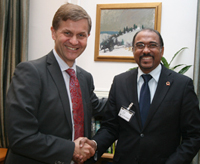
Mr Erik Solheim, the Norwegian Minister of International Development and Environment (left) meets Mr Michel Sidibé, UNAIDS Executive Director in Oslo, 7 May 2009
Credit: Secretariat of the Minister of International Development, Norway
The Nordic countries are staunch supporters of the global AIDS response and have supported UNAIDS both politically and financially since its inception. This week UNAIDS met with four Nordic countries, Norway, Sweden, Denmark and Finland to exchange knowledge and outline priorities for the upcoming year.
The Nordic countries place great emphasis on the informal and interactive format of these annual consultations with UNAIDS which this year were hosted by Norway in Oslo.
“The Consultations are a true example of a genuine partnership – and cooperation among friends,” said Michel Sidibé, Executive Director of UNAIDS. “We hold honest discussions which provide essential feedback for UNAIDS’ work,” he added.
The Consultations are a true example of a genuine partnership – and cooperation among friends. We hold honest discussions which provide essential feedback for UNAIDS’ work.
Michel Sidibé, Executive Director of UNAIDS
Topics up for discussion this year included vulnerable populations, including migrants; dealing with the financial crisis; linking the AIDS response and the Millennium Development Goals; health system strengthening and delivery; and where UNAIDS should be in the global health architecture.
During the visit to Oslo, Mr Sidibé also met with the State Secretary Solveig Torsvik, the Deputy Secretary General, Atle Leikvoll, the Minister of International Development and Environment Erik Solheim.

Mr Michel Sidibé, UNAIDS Executive Director visited Her Royal Highness Crown Princess Mette Marit in Oslo on 7 May 2009
Credit: Sara Johannesen, Scanpix
Mr Sidibé also took the opportunity to visit Her Royal Highness Crown Princess Mette Marit.
The Crown Princess renewed her support to UNAIDS and discussed a number of initiatives she is currently involved in including the aids2031 Young Leaders Summit which is taking place in Oslo next month where she pledged to raise awareness about HIV and young people.
The Crown Princess has been working with UNAIDS since 2006, helping to generate awareness and support for young people living with HIV. In 2008 while visiting Ukraine she met with young people involved in peer education and people living with HIV as well as many others working in the country’s AIDS response. The Crown Princess has also used her status to raise awareness around women and HIV, notably during the XVI International AIDS Conference in Toronto in 2006 and during a fact finding mission to Nicaragua in 2007.
The meetings in Oslo concluded on Friday with a dialogue between participants and Nordic civil society groups.

